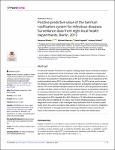Positive predictive value of the German notification system for infectious diseases: Surveillance data from eight local health departments, Berlin, 2012
Blümel, Benjamin
Diercke, Michaela
Sagebiel, Daniel
Gilsdorf, Andreas
The German Infection Protection Act requires notifying certain cases of infectious diseases to local health departments (LHD) in Germany. LHDs transmit notifications meeting case definitions to the national health authority, where the proportion of discarded notifications is not known. The proportion of discarded cases at the level of LHDs can be expressed as the positive predictive value (PPV) of the notification system. The PPV can be used to assess the efficiency of the system. We quantified the proportion of discarded notifications to calculate the PPV of the German notification system at the level of LHDs using electronic notification data from Berlin LHDs from 2012. We also analysed reasons for discarding notifications by reviewing notification forms. Data was available from eight LHDs (67%) receiving 10,113 notifications in 2012. Overall PPV was 89% (minimum-maximum = 77–97% across LHDs) and ranging from 30% (Hepatitis B) to 99% (Rotavirus). Of 166 individual investigation forms 84% were on hepatitis B or C cases, most of them discarded because of previously diagnosed chronic disease. LHDs investigate many notifications that do not lead to public health action and useful surveillance data leading to inefficient use of resources. Adaptation of case definitions or the legal framework concerning notifications may increase the efficiency of the notification system and lead to better use of data from notified cases.

